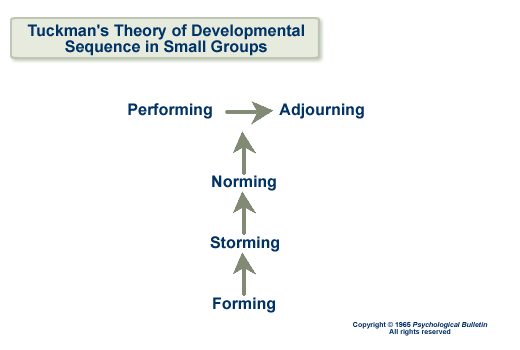Team Development In 1965 Dr. Bruce Tuckman published his Theory of Developmental Sequence
in Small Groups. His model addresses how groups change over time, and
identifies stages of team development. These stages are: forming, storming,
norming, performing, and adjourning. Tuckman's model helps us to identify
predictable stages that a group experiences as it progresses from being
a collection of individuals to a cohesive team working together to achieve
a common goal. Below is Tuckman's diagram of the Team Development Stages: When a group of individuals come together to create a team they have
an opportunity to enter the forming stage. In this orientation
period the members of the team are learning about each other: the skills,
knowledge and expertise that each of them can contribute to the group. Following the forming stage it is common for teams to move into a stage
that Tuckman has called storming. With members of the team taking
on specific roles and responsibilities this is a time when individuals
vie for positions within the group. It can be a time of confusion as
the team learns to communicate effectively and also struggles for control. Once the team moves through the storming stage, Tuckman suggests that
the team moves to a stage called norming. During this stage the
team has a sense of unity. The roles within the team are established
and the team reaches consensus on determining its collective goals and
objectives. Once the team begins to norm together they work toward the performing
stage. This is when teams are functioning at their peak performance.
At this point, the team has acknowledged the skills, and expertise that
individuals bring to the team and they are working as a cohesive unit. Tuckman's theory did not end with peak performance. He later wrote
that the final stage is adjourning. Adjourning happens either
when one or more individuals leave the team and new members join the
team, or the team goal was achieved. This ending of the team is just
as important to acknowledge as the beginning.2 For a group in which the task is clearly defined and is perceived by
all members as important, the first three stages may be dealt with in
the first few hours of meeting. However for most groups it takes longer
to move through these stages and this process needs to be anticipated.
Project managers, particularly those involving people from different
parts of the organisation, need to plan for and allow time for group
development. 1
Tuckman, 1965, pages 384-399

![]()
![]()
2
Tuckman & Jensen, 1977, pages
419-427
All rights reserved